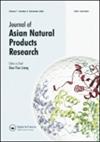利用网络药理学和实验验证,探讨芪甲扶正方通过STAT1/CXCL10促进肺腺癌微环境中CD8+ t细胞浸润的机制。
IF 1.3
3区 医学
Q3 CHEMISTRY, APPLIED
引用次数: 0
摘要
研究七家扶正方(QJFZF)是一种用于治疗肺癌和减轻化疗副作用的中药,旨在阐明其对肿瘤免疫微环境(TIME)的影响。通过网络药理学和实验验证,从579个qjfzf相关靶点和752个肺腺癌(LUAD)时间靶点中鉴定出39个重叠靶点。关键基因CCL3、IL10、CXCL10、FOXP3、CD86与肿瘤纯度呈负相关,与CD8+ t细胞浸润呈正相关。CXCL10成为核心靶点,实验显示QJFZF激活STAT1/CXCL10通路,在LUAD-TIME增强CD8+ t细胞募集。本研究阐明了清热通络方的免疫调节机制,为其临床应用提供支持。本文章由计算机程序翻译,如有差异,请以英文原文为准。
Utilizing network pharmacology and experimental validation to explore the mechanisms of the Qijiafuzheng formula promoting CD8+ T-cell infiltration in the microenvironment of lung adenocarcinoma through STAT1/CXCL10
Qijiafuzheng formula (QJFZF), a Traditional Chinese Medicine used to treat lung cancer and mitigate chemotherapy side effects, was studied to clarify its impact on the tumor immune microenvironment (TIME). Using network pharmacology and experimental validation, 39 overlapping targets were identified from 579 QJFZF-related and 752 lung adenocarcinoma (LUAD)-TIME targets. Key genes (CCL3, IL10, CXCL10, FOXP3, CD86) correlated negatively with tumor purity and positively with CD8+ T-cell infiltration. CXCL10 emerged as the core target, with experiments showing QJFZF activates the STAT1/CXCL10 pathway to enhance CD8+ T-cell recruitment in LUAD-TIME. This study elucidates QJFZF’s immunomodulatory mechanisms, supporting its clinical application.
求助全文
通过发布文献求助,成功后即可免费获取论文全文。
去求助
来源期刊
CiteScore
3.20
自引率
5.90%
发文量
47
审稿时长
2.3 months
期刊介绍:
The Journal of Asian Natural Products Research (JANPR) publishes chemical and pharmaceutical studies in the English language in the field of natural product research on Asian ethnic medicine. The journal publishes work from scientists in Asian countries, e.g. China, Japan, Korea and India, including contributions from other countries concerning natural products of Asia. The journal is chemistry-orientated. Major fields covered are: isolation and structural elucidation of natural constituents (including those for non-medical uses), synthesis and transformation (including biosynthesis and biotransformation) of natural products, pharmacognosy, and allied topics. Biological evaluation of crude extracts are acceptable only as supporting data for pure isolates with well-characterized structures.
All published research articles in this journal have undergone rigorous peer review, based on initial editor screening and anonymized refereeing by at least two expert referees.

 求助内容:
求助内容: 应助结果提醒方式:
应助结果提醒方式:


